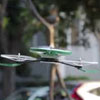
Drones: The Future of Bonding with Your Neighbors
- By Ginger Hill
- Jun 16, 2014
Remember the good old days when neighbors would come over and ask to borrow a cup of sugar? A similar situation happened to me just a few days ago. There was a light knock on the door. Opening it revealed a woman with her 2-year-old son standing at my front door asking to borrow a can opener. What a nostalgic moment! However, drones could soon take the place of moments such as these.
A new Kickstarter project by Fatdoor is re-launching a social network for connecting neighbors that closed in the late 2000s, perhaps with a bit more to offer. While the site will have traditional services that allow neighbors to post thoughts and sell items, a custom drone, the Skyteboard 3G, will also be integrated. Soon to (possibly) be hovering around neighborhoods, this drone can be controlled over the Internet even when it isn’t connected to a Wi-Fi network via iOS and Android apps as well as controls built directly into the Fatdoor network.
Fatdoor’s ultimate goals with Skyteboard 3G:
- Allow neighbors to synchronize flight paths;
- Set landing locations outside homes to make deliveries easy;
- Facilitate interaction in local communities; and
- Restore lost communication between neighbors.
Although this drone already has a built-in camera, Fatdoor suggests mounting a GoPro camera on it to create a two-camera system to record kid’s soccer games. (Nothing like buzzing above Little Johnny’s head, recording his first goal.) And, with a squad of these Skyteboard 3G drones, a banner could be flown around a neighborhood advertising an event.
Is it just me or does the whole possibility of hacking the drone or the cameras to create security issues cross anyone else’s mind? And, flying a banner announcing an event? Hmmm, sounds like a huge invitation to burglars to come rob your neighborhood when everyone’s at the block party.
About the Author
Ginger Hill is Group Social Media Manager.